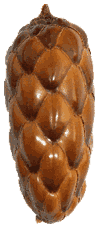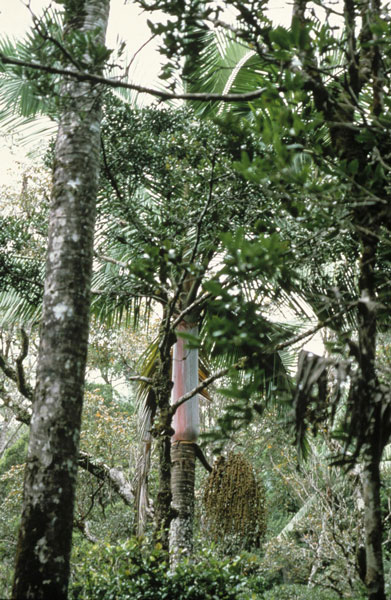 |
Palm |
 |
Palm |
Lemurophoenix halleuxii is restricted to tropical rain forest on hills surrounding the Bay of Antongil in northeastern Madagascar; it is known from three small populations, one of which consist of a single individual. It occurs on steep slopes and in valley bottoms, at an elevation of approximately 200–450 m above sea level.
It is a massive palm of the forest canopy, with solitary stems to 20 m tall and c. 1 m diameter at the very base, and ca. 50 cm diameter near the leaves. There is a massive crownshaft about 1 m long composed of pink-tinged, green leaf sheaths. The leaves are approximately 4.25 m long, and have a very short petiole, and many crowded leaflets. The massive inflorescence, to 2 m long, is held below the crownshaft and has over 100 flower-bearing branches. The male flowers are small, approximately 8×5 mm, and have over 50 stamens. The fruit is rounded and instantly recognized by its relatively large size (50 mm in diameter) and the curious covering of low brown corky-warts, a fruit type unique in Madagascar to this genus. Inside the fruit wall, the endocarp is smooth apart from a heart-shaped basal button. The endosperm is shallowly ruminate, and the embryo is apical.
Little is known about the natural history of the species. Ripe fruit accumulate in large numbers under trees (unless harvested by seed collectors) suggesting that there is little, if any, effective dispersal.
The forests where the palm occurs are included within the Parc National de Masola, or in the proposed Makira protected area. Despite this, seed collectors harvest seeds, and there may, at least in the past, have been some felling of trees for the edible palm hearts.
 |
| The crown of Lemurophoenix halleuxii partially obscured by surrounding vegetation. Note the pinkish crownshaft. Photo by D. Cooke. |
Apart from the inclusion of the habitat within protected areas, there are no current specific conservation measures.
A demographic study of the palm should be performed, and the species should also be searched for elsewhere. A population genetic study would be of great value to ascertain the long-term viability of the populations.
Dr. John Dransfield, Herbarium, Royal Botanic Gardens Kew, Richmond, Surrey, TW9 3AE, UK (j.dransfield@kew.org)
Dransfield, J. 1991.
Lemurophoenix (Palmae: Arecoideae), a new genus from Madagascar.
Kew Bull. 46: 61–68.
Dransfield, J. & H. Beentje. 1995.
Palms of Madagascar.
Royal Botanic Gardens, Kew.
Dransfield, J, H. Beentje, A. Britt, T. Ranarivelo & J. Razafitsalama. 2006.
Field Guide to the Palms of Madagascar.
Kew Publishing, Royal Botanic Gardens, Kew.
Dransfield, J, H. Beentje, A. Britt, T. Ranarivelo & J. Razafitsalama. 2006.
Torolalan’ireo Satrapotsy (Palmier) eto Madagasasikara.
Kew Publishing, Royal Botanic Gardens, Kew.